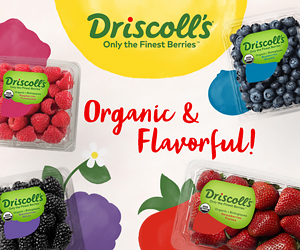Agrauxine, the US business unit of France-based yeast manufacturer Lesaffre, is dedicated to biosolutions for a wide range of agricultural crops. Lesaffre has been in the microorganism business for 170 years now, and the US operation has been in business since 2000.
Agrauxine develops, manufactures, and commercializes biocontrol solutions for crop protection and plant nutrition for plant yield and quality improvements.
Pete Hayes, Vice President of Marketing, Agrauxine
“Lesaffre ... realized 15-20 years ago that some of the byproducts of its yeast manufacturing process, specific for bread, wine, and alcohol in particular, could be used for plant health as well as animal health, human health, and flavor additives,” said Pete Hayes, vice president of marketing for the Van Wert Ohio-based company. “Our ambition is to continue to bring to market sustainable and high-performing products.”
There are four Agrauxine products that are registered organically—Romeo, Romeo CA, Julietta, and Smartfoil. Compared to other biologicals approved for use in organic production, Agrauxine’s products have high tolerances to environmental conditions and what they are being combined with.
“Lesaffre ... realized 15-20 years ago that some of the byproducts of its yeast manufacturing process, specific for bread, wine, and alcohol in particular, could be used for plant health, as well as animal health, human health, and flavor additives.” - Pete Hayes
“Each of these products are yeast derived,” said Shannon Pike, business development manager for Agrauxine by Lesaffre. “Whether it’s the whole yeast cell or the metabolites or byproducts of the yeast manufacturing process, there are very few restrictions of use for each of these products. Each yeast-based product was specifically selected for its ability to positively contribute to crop yield and quality improvements.”
Shannon Pike, Business Development Manager, Agrauxine
For example, Smartfoil is the liquid that is extracted from the yeast manufacturing process. Smartfoil reduces plant stress at flowering and amplifies metabolic response on several levels (genomic, cellular, and physiological) during the critical stages of development to protect the yield.
“The product helps offset the abiotic stress that a plant would go through in extreme heat, dry weather, or wet weather and keeps flowers from aborting,” Pike said. “We’re getting great results in the field from farmers using the product.”
Agrauxine’s EPA-approved Romeo and Romeo CA biocontrol products are non-living, yeast-cell membranes from a specific yeast species (Saccharomyces cerevisiae strain LAS117). The active ingredient of Romeo and Romeo CA interacts with the plant at a molecular level, stimulating the plant to activate its own defense system, therefore offering a preventative disease protection response to a broad range of plant pathogens.
“We’re just scratching the surface with Romeo and Romeo CA,” Hayes said. “They are available not only for the specialty crop market but also for use in row crops.”
“The product helps offset the abiotic stress that a plant would go through in extreme heat, dry weather, or wet weather and keeps flowers from aborting. We’re getting great results in the field from farmers using the product.” - Shannon Pike
Another EPA-approved biocontrol product from Agrauxine is Julietta. Julietta is a living yeast (Saccharomyces cerevisiae strain LAS02) and a species that was selected for being prolific and surviving very well under a wide range of pHs and temperatures.
“What it does is it out-competes undesirable pathogens for space and resources on the leaf plant and the fruit surface of the plant,” Pike said.
Julietta's natural origin makes it an environmentally friendly solution, and it can be used in conventional, sustainable, and organic agriculture.
.png)
Three years ago, Agrauxine purchased Advanced Biological Marketing, Inc., which brought along with it Trichoderma and Rhizobium seed treatments, some of which are approved for use in organic production.
The biggest challenge that Agrauxine faces in 2023 is the economic climate and brand recognition.
“What it does is it out-competes undesirable pathogens for space and resources on the leaf plant and the fruit surface of the plant.” - Shannon Pike
To that end, the company will be at the Organic Grower Summit at the end of November in Monterey, California, and invites people to stop by its booth and learn more about these products.
“We’re trying to get people to recognize who we are and what we do,” Pike said. “We focus on biologicals, so we are a relatively small company compared to some of the bigger players.”
Agrauxine continues to look for products to align with its philosophy and notes there are some soil amendments in the pipeline as well as some products that can be used in combination with some other biological products.

Hayes noted the company has a very extensive research and development sector, and nothing goes to market until it’s been tested in the field to ensure that it works.
“Because we are connected with Lesaffre, quality control measures are a top priority,” he said. “Employee safety is number one, and right after that comes quality control. Much of what they have learned over the decades, they make sure that the products they supply to their subsidiaries from their own manufacturing facilities meet the same quality standards for performance consistency.”
Agrauxine continues to look for products to align with its philosophy and notes there are some soil amendments in the pipeline as well as some products that can be used in combination with some other biological products.
The more that Agrauxine understands the interactions between its products and plants, soil, and microorganisms, the more it realizes that much of its products' efficacy comes from helping plants do what they would do naturally.
“It’s more of an assist to what’s already there environmentally and genetically,” Pike said. “We’re helping the plant fight what’s coming at it, whether that be some type of pest or simply stress; the plant has that built-in capacity, and we just strengthen that.”






